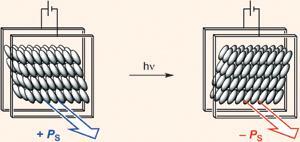Investigations highlighted by Bob Lemieux of Queens University, Ontario have led to a greater understanding of the mechanisms of ferroelectric liquid crystal photoswitching.
Investigations highlighted in a new review by Bob Lemieux of Queens University, Ontario have led to a greater understanding of the mechanisms of ferroelectric liquid crystal photoswitching and have revealed further challenges facing researchers in this area.

Photochromic dopants have been designed which can trigger the ON-OFF switching of ferroelectric liquid crystals. Ferroelectric liquid crystals are currently used in high resolution reflective liquid-crystal-on-silicon microdisplays and show potential for use in photonic devices, non-linear optics and chiral sensor applications. Liquid crystals can be switched between orientations by stimuli such as electrical or magnetic fields, heat, mechanical force, or light. When a thin film of ferroelectric liquid crystal is positioned between crossed polarized filters, it can function as a light shutter that can be turned ON and OFF by these stimuli. Photoswitching, where light promotes this switch, can be achieved either by incorporating photoconductive or photodiode layers into devices, or by using a photoisomerizable dopant. The incorporation of these units allows the reversible inscription of images, diffraction gratings or wavelengths onto ferroelectric liquid crystal films. Azobenzene-, diethienylethene- and thioindigo-derived chiral dopants have proved promising as photoswitches, and have revealed vital information about the mechanisms involved in photoswitching.
It is hoped the greater understanding of the mechanisms of dopant modulated photoswitching and of the structure-property relationships of these chiral dopants will lead to the development of photochromic dopants which show bistability, fatigue resistance, and greater compatibility with smectic phases. These ’optical transistors’ will hold great potential for emerging photonic and telecommunication applications.
Rebecca I Gillan
References
R P Lemieux, Soft Matter, 2005, 1, 348, (DOI: 10.1039/<MAN>b511149h</MAN>)






No comments yet